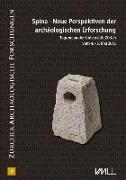- Start
- Spina
Spina
Angebote / Angebote:
Die etruskische Stadt Spina am Südrand des heutigen Po-Deltas spielt in der Forschung aufgrund der 1922 entdeckten und sukzessive freigelegten Gräberfelder mit mehreren tausend Gräbern eine herausragende Rolle, vor allem wegen eines der bedeutendsten Fundensembles attischer Keramik im ganzen Mittelmeerraum. Seit 2007 wird im Rahmen eines internationalen Forschungsprojektes das antike Stadtzentrum im Hinblick auf Urbanistik, Wohnarchitektur, Naturraum, Stratigraphie und absoluter Chronologie erforscht, dessen reiche Ergebnisse hier erstmals zusammenfassend in 15 Beiträgen vorgelegt werden. Konkret geht es dabei um die frühhellenistische Phase und die Salzsiederei Spinas, die Strukturen des 4. Jhs. v.Chr., künftige Forschungsperspektiven, den geoarchäologischen Kontext und die Stratigraphie der etruskischen Siedlung, paläobotanische Forschungen, Bautechnik und Nutzung der Holz-Lehm-Bauten des 6.-4. Jhs. und die Typen der Grobkeramik und Feinkeramik. Vergleichend werden die etruskische Siedlung von Adria, neue Forschungen und attische Keramik aus Mantua sowie die Nekropolen von Valle Pega [ein Beitrag] und Valle Trebba [4 Beiträge] vorgestellt./ The Etruscan town of Spina on the southern edge of the present-day delta of the River Po has long been in the focus of research because of its cemeteries discovered in 1922 and excavated successively. Their several thousand graves contained one of the largest find complexes of Attic pottery in the entire Mediterranean. Since 2007, an international research project has been dedicated to the investigation of the ancient town centre with regard to urbanism, housing architecture, natural environment, stratigraphy, and absolute chronology. The rich results are first presented here in the shape of 15 overview papers. These deal with the Early Hellenistic phase and evaporative salt production at Spina, the structures of the 4th century B.C., future perspectives of research, the geo-archaeological context and the stratigraphy of the Etruscan settlement, the palaeobotanical evidence, building technique of and everyday life in the timber and daub houses of the 6th to 4th century, and the types of coarse and fine pottery wares. For comparison, the Etruscan settlement at Adria, new research and Attic pottery from Mantua, and the cemeteries at Valle Pega [one article] and Valle Trebba [four articles] are discussed.
Libri-Titel folgt in ca. 2 Arbeitstagen




